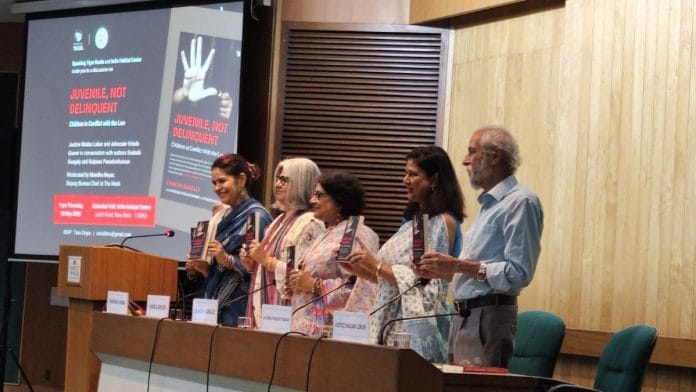New Delhi: With their new book, Juvenile, Not Delinquent: Children in Conflict With the Law, authors and activists Enakshi Ganguly, Kalpana Purushothaman and Puneeta Roy hoped to educate people on the nuances of child rights and juvenile justice – by using the 2012 Nirbhaya rape case as a launchpad. But on the evening of its big release at Delhi’s India Habitat Centre last Thursday, they were reminded of the near insurmountable task ahead of them.
Instead of looking at the intended broader picture about the human rights of minors who commit crimes, the question and answer portion of the event quickly devolved into a morality slugfest that harkened back to December 2012.
Some male audience members attempted to re-litigate the Nirbhaya rape case with a laser focus on its graphic details, leading to a war of words between them and the activist-heavy panel, which, apart from two of the three authors, featured lawyer Vrinda Grover and former Supreme Court judge, Justice Madan Lokur. It was chaired by TheWeek’s deputy bureau chief, Mandira Nayar.
Also read:
Re-litigating the Nirbhaya case
After Ganguly explained how the research for Juvenile, Not Delinquent – a Speaking Tiger publication – was formed out of the discourse surrounding the Nirbhaya case, the panel spent an hour attempting to establish their respective views and first-hand experiences dealing with “children in conflict with the law”, or CICLs as termed by the Juvenile Justice Act 2015.
“The boy/man who brutalised her in pathological, animal ways…suppose the man is 15 days away from what the State considers is maturity, adult time for adult crime. Where do we stand in cases like this? It’s a moral conflict,” asked one man.
In response, Justice Lokur stressed on the need for “some degree of arbitrariness in lawmaking” and that the line for minimum adult age has to be drawn somewhere, similar to legal ages for driving, drinking and voting.
“Accept it. Some people may fall on this side of [the line], some may fall on the other side. But if it is somebody who is, say [a borderline case], you’re choosing between three years and life [sentencing]; there’s a huge difference. That’s where I think aspects like the best interests of the child, such as rehabilitation and reintegration, should [come into play], for adults as well,” Justice Lokur added.
Ganguly concurred with Justice Lokur’s arbitrariness argument and called out what she perceived as double standards regarding offences compared to driving or voting. She also revealed insights from the Nirbhaya case chargesheet against the convicted minor.
“It was a 470-page chargesheet. Nowhere in that chargesheet was there any mention of an iron rod, of antariyaan [intestines] being pulled out. Where did it all come from? We need to actually raise questions about the role of the media,” Ganguly said.
Ganguly’s response, however, caused great commotion. The panel and the audience began talking over each other, instigating a renewed debate on misinformation. It also triggered a more accusatory question toward the panel from another man in the audience, who insisted that a “chargesheet is not gospel” and that the media did not “concoct” stories on the Nirbhaya case.
By this point, Ganguly and company appeared to have lost all control over their audience, which seemed quite adamant about escalating the situation to a shouting match – a far cry from the peaceful but interesting note the discussion began on.
Also read:
Researching the rights of CICLs
To kick off the talk, Ganguly stated that the book was best summed up by South African comedian Trevor Noah’s quote that, unlike government, crime “cares”.
“The hood made me realise that crime succeeds because crime does one thing government doesn’t do. Crime cares. Crime is grassroots. Crime looks for young kids who need support and a lifting hand. Crime offers internship programmes and summer jobs, and opportunities for advancement. Crime gets involved in the community. Crime does not discriminate,” said Ganguly while reading a quote from Noah’s memoir, Born A Crime, which also introduces Juvenile, Not Delinquent.
Ganguly then proceeded to talk about how people in the women’s rights and human rights movement suddenly found themselves “no longer on the same page” due to the Nirbhaya case.
“It was a very disturbing phase. That is a time of our lives when many of us would go back to and think about what we mean when we say human rights without discrimination, rule of law. Those are the touchstones when we are challenged the most. That really was the genesis of the book,” Ganguly added.
Vrinda Grover later expressed slight disagreement over the contextual nuances of Ganguly’s assessment of the Nirbhaya case discourse, stating that the more feminist elements of the movement were not “at loggerheads” over the case and the minor convict, who was reportedly “a few months short” of turning 18 at the time.
“It’s actually not very complicated. There was a lot of rage and outrage. I don’t think it was for justice to begin with. We need to deconstruct why this rage was happening, and there were multiple voices, which is not a bad thing,” Grover said. She added that it is a “misnomer” that justice should ever be a competition between the victim’s rights and the accused’s rights.
“Justice can never be about aggregated power in the hands of the State.”
(Edited by Zoya Bhatti)






